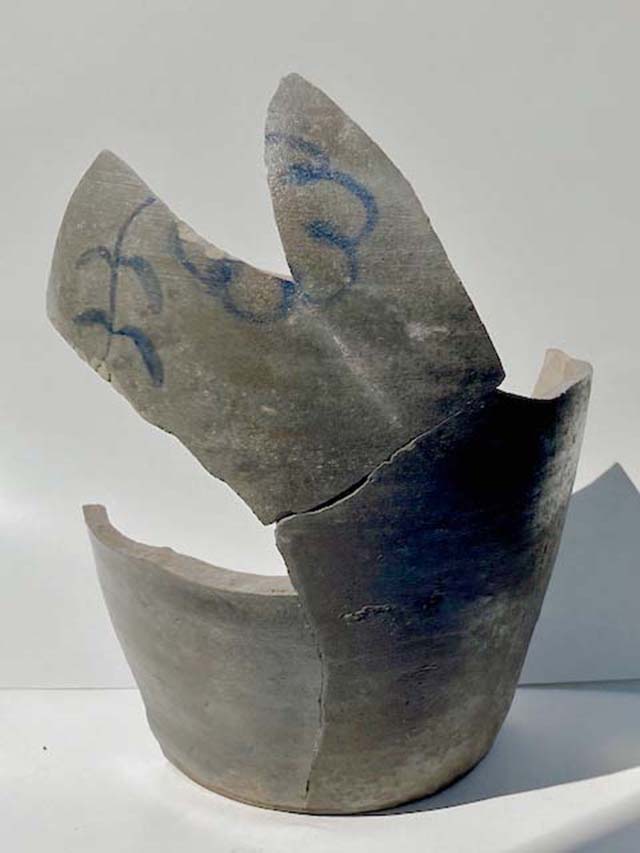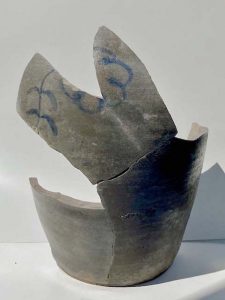Ask an Archaeologist: Stephen Sweeney Pottery


I received an email from Michael Goodwin who discovered some pieces of pottery at the “old family home” off US 33 near an area historically known as Cuckoo, in Louisa County. He recovered them around the year 2000, pieced them together, and found he had a substantial portion of the original vessel. Mr. Goodwin wanted to know if I could help him learn more about it.
Right away, all I could tell was that it was grey, salt-glazed stoneware and likely local. I sent an email to Rob Hunter, the editor and founder of the wonderful ongoing Ceramics in America series of books. The 2020 and previous editions discuss ceramics found in the U.S. in all their forms—from tobacco pipes to milk pans. The publications are widely esteemed for their scholarly articles and beautiful photography.
Within minutes, Rob Hunter answered: Mr. Goodwin’s sherds were the work of Stephen B. Sweeney (or a potter working for him) from between ca. 1840 and 1860. Sweeney’s pottery operation was located to the east of Richmond along New Market Road, today’s Route 5 (John Tyler Highway). That area of Henrico County, along Baily’s Creek and Four Mile Creek, was the location of several well-established pottery makers by the late 1700s and well into the later 1800s. The location contained good clay sources and transportation routes to Richmond and east to Williamsburg, by road or the nearby James River. Sweeney, who had 237 acres by 1854, named his property “Claymount,” an indication of the area’s extensive clay deposits.
Sweeney’s agricultural and pottery operations at Claymount grew—period maps show Sweeny’s “Pottery & Hotel” and another nearby “Sweeney’s Pottery”—supported by enslaved laborers (Sweeney’s will listed 19 enslaved persons). How many of the enslaved worked in the pottery is unknown. (Among Sweeney’s known potters was a free Black, Walt “Watt” Green.)
The information about Sweeney comes from an article that Hunter sent “The Remarkable 19th-Century Stoneware of Virginia's Lower James River Valley,” from the 2013 edition of Ceramics in America. Co-authored by Kurt C. Russ, Hunter, Oliver Mueller-Heubach, and Marshall Goodman, their publication richly details the significant Richmond and James River stoneware production of the 19th century. Sweeney’s pottery played an important part in that story. The publication includes photographs of Sweeney’s work (see Figs. 47 and 48, at the link). It is clear that Mr. Goodwin’s vessel came from the Sweeney pottery. According to Hunter et al, “[Sweeney’s] most common decorative treatment consists of a single floral stem, extending from two opposing outlined leaves, that terminates in a circular blossom. In many cases the blossom is rendered without stem and leaves, appearing cloudlike.”
Pottery production along the Rt. 5 and lower James River Valley is impressive. The authors note in their article that “stoneware manufacture in Richmond, southern Henrico County, Charles City County, and the Petersburg/Dinwiddie County areas involved as many as sixteen different operations and some forty identified potters. Those potters, who labored at various places at various times, alternating between cooperation and competition, were responsible for the production of a unique body of wares, tangible evidence of connections across space and time.”
–Mike Clem
Archaeologist, Eastern Region Preservation Office
State Archaeology Division
Read other blogs in the Ask an Archaeologist series.










